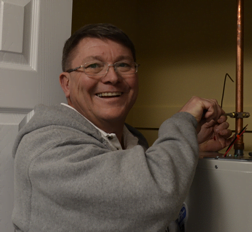Frozen water pipes burst because when water freezes it expands. This expansion causes a build-up of pressure in the pipe causing it to nurse.

Subfreezing weather is right around the corner which means the possibility of frozen pipes and leaks. You should take some precautions which can save you from property damage, big bucks and much heartache.
OUTSIDE FAUCETS: We all have at least one outside hose faucet. In the trade we call them hose bibs, sill cocks or frost free hydrants. Today, we’ll refer to all three as a hose bibb. Usually each hose bibb has a valve inside the house which is used to winterize it.
This valve is generally located inside the house very near the hose bibb location. To winterize your hose bibb, you want to turn off the valve inside. Outside, disconnect your hose from the bibb. You will want to drain the water out of the hose to prevent one big coil of ice. Open the hose bibb and leave it open. A little bit of water should dribble out.
Next, you want to look around your basement for any water pipes that are on the outside wall. If you had your basement finished or insulated recently, you want to look for pipes that have been covered up. These pipes can freeze up in a real hurry on cold winter nights.
We had a customer a few years ago who called me on a Sunday night with 2” of water in his nice, newly finished basement. Turns out the contractor installed 2 x 4 studs on the exterior wall and finished with sheetrock. The pipe to the hose bibb ran down the exterior wall about 6’ from the ceiling and connected to the hose bibb. With no insulation, and sheet rock isolating the pipe from the basement heat, the pipe froze, split and flooded his basement. Carpet, wood molding, sheetrock and personal items stored on the floor were soaked. The wife was in tears.
A real mess that cold Sunday night.
Now, if your kitchen sink is on an outside wall, you will want to locate the hot and cold pipes feeding your kitchen sink in the ceiling of your basement. Often there is an ‘overhang” on the rear of a house with the sink cabinet partially sitting on the overhang. Your hot and cold pipes may be in this overhang and subject to cold air from below the overhang outside. Check to make sure you have A LOT of building insulation around these pipes. Also be certain that basement heat can reach these pipes in the overhang. Even if you don’t have an overhang, your kitchen sink, or any fixture for that matter, may have pipes in the basement ceiling that may extend over your foundation wall and be very close to the band board (The outside board above the foundation wall) and not have insulation between them and the band board. Check it out!
Check for small cracks in your basement walls near pipes. You can do this by turning out the basement lights on a bright day and looking for sunlight. On a cold, windy winter day wind blowing thru a crack onto a pipe will freeze that pipe almost instantly. Even if the pipe is in a ‘warm” spot.
Don’t forget to drain the water out of your garden hoses before coiling them up for storage.
Finally, locate your main water valves and turn it off to make sure it works. If you do experience a bursted pipe, you will know how to shut the water off quickly to minimize property damage. Make sure everyone in your house knows how to shut off the main water valve. That little piece of knowledge could save you thousands of dollars in damage and much heartache.
Pat Scheper, Vice President & Master Plumber
Apple Plumbing & Heating
Same Day Emergency Service available! Call us at 410-840-8118 or fill in the form.





